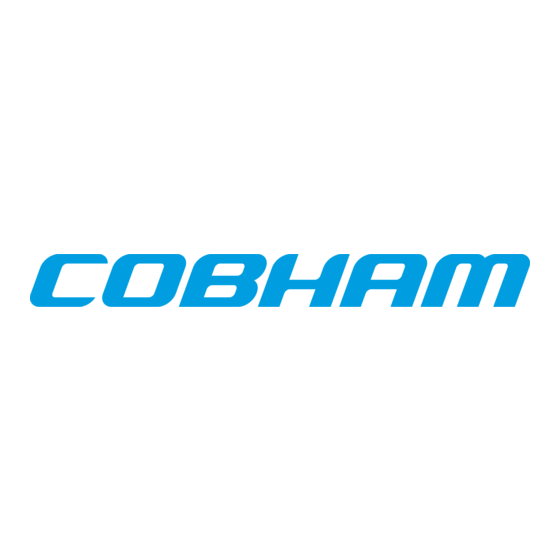
Table of Contents
Advertisement
Quick Links
Download this manual
See also:
User Manual
Advertisement
Table of Contents
Troubleshooting

Summarization of Contents
Chapter 1 About this manual
1.1 Purpose
Explains the manual's objective: to provide installation, maintenance, and troubleshooting info.
1.2 Organization
Outlines the structure and content covered in each chapter of the manual.
1.3 Related documentation
Lists other relevant manuals and documentation for the system.
1.4 Precautions: Warnings, Cautions and Notes
Defines symbols used for warnings, cautions, and important notes.
Chapter 2 Introduction to the AVIATOR 200/300/350
2.1 General description
Provides an overview of the system's technical aspects, features, and components.
2.1.2 AVIATOR 200/300/350 features
Lists key capabilities and functionalities of the AVIATOR 200/300/350 system.
2.2 Application
Details the minimum system requirements and applicable part numbers.
2.3 System block diagrams
Illustrates the interconnection of system components for various configurations.
Chapter 3 Equipment drawings
3.1 Introduction
Introduces the outline drawings of important system units for installation.
3.2 Core System Components Drawings
Provides outline drawings for key system units like SBU, HLD, trays, and connectors.
3.12 TT-5040A-004 WLAN antenna
Presents the outline drawing for the TT-5040A-004 WLAN antenna.
3.13 Switch Annunciator Panel
Provides the outline drawing for the Switch Annunciator Panel.
Chapter 4 Connectors and pin-out
4.1 TT-5040A SBU
Details the connectors and pin-out for the TT-5040A SBU.
4.2 TT-5016A HLD
Details the connectors on the TT-5016A High Power Amplifier/Low Noise Amplifier/Diplexer.
4.3 TT-5622B 2-Wire Cradle
Details the connectors on the TT-5622B 2-Wire Cradle.
4.4 Mating connectors in aircraft
Details mating connectors for SBU connection in aircraft.
Chapter 5 Installation
5.1 General installation information
Provides general considerations and recommendations for system installation.
5.2 Mounting considerations
Outlines guidelines for optimal system component installation and placement.
5.3 Electrical installation and wiring
Details electrical installation and wiring requirements for system components.
5.4 Recommended cables
Lists recommended cables and allowed lengths for system use.
5.5 Activation of airtime services
Explains the process of activating airtime services for system operation.
Chapter 6 Configuration of the AVIATOR 200/300/350 system
6.1 Configuration Tasks
Outlines essential initial configuration steps for the system.
6.2 Tool for setup and use: Built-in web interface
Guides on accessing and using the system's web interface for setup.
6.5 To set up the interfaces
Details how to configure various system interfaces like LAN, WLAN, ISDN, etc.
6.6 LAN/WLAN network users
Guides on managing network user groups and devices for flexible data channel use.
6.7 Administration
Covers administrative settings like security, configuration management, and logging.
6.10 AVIATOR 200/300/350 system ready for use
Provides final checks to verify the system is fully operational.
Chapter 7 Maintenance and troubleshooting
7.1 Continued Airworthiness
States system requirements for maintenance and contact information for support.
7.2 Technical Support and Maintenance
Guides on obtaining technical support and performing maintenance tasks.
7.5 Troubleshooting
Details status signalling, LEDs, reset buttons, and initial troubleshooting steps.
Appendix A Equipment specifications
A.1 Introduction
Introduces equipment specifications and notes on included items.
A.2 AVIATOR 200/300/350 system components
Lists detailed specifications for SBU, CM, HLD, WLAN antenna, and Rx Power Splitter.
A.3 AVIATOR 200/300/350 handsets and cradles
Lists equipment specifications for 2-Wire Handset and Cradle.
Appendix B DO-160 specifications
B.1 General
Mentions certifying agency and environmental qualification forms.
B.2 AVIATOR 200/300/350 system components
Lists DO-160E environmental qualifications for SBU, CM, HLD, and Rx Power Splitter.
B.3 AVIATOR 200/300/350 handsets and cradles
Lists DO-160D environmental qualifications for handsets and cradles.
Appendix C System messages
C.1 Types of messages
Introduces the system messages announced in the web interface.
C.2 List of events
Explains system events (warnings and errors) shown in the web interface.
Appendix D WLAN country codes
D.1 Restrictions in WLAN use
Discusses restrictions on WLAN channel usage and country code settings.
D.2 Countries where the “US” country code applies
Lists countries where the default US country code is applicable for WLAN.
Appendix E References
E.1 Applicable standards
Lists applicable standards and references relevant to the system.
Appendix F TT-5019A Iridium Band Reject Filter
F.1 Introduction
Introduces the Iridium Band Reject Filter and its purpose.
F.2 Equipment Drawing and Installation
Provides equipment drawings and installation/wiring guidelines.
F.5 Specifications
Lists the technical specifications for the Iridium Band Reject Filter.
F.6 DO-160 specifications
Details the DO-160 environmental qualifications for the filter.
Appendix G Terminal commands
G.1 Get started
Guides on connecting to the SBU using a telnet client.
G.2 Commands for troubleshooting the SBU
Explains commands for monitoring ARINC interfaces and status reports.
Appendix H SIP setup for Wifi-enabled phones
H.1 Introduction
Introduces SIP setup for Wifi-enabled phones connecting via WLAN.
H.1.1 Connect to the WLAN interface
Guides on connecting a phone to the SBU WLAN interface.
H.1.2 Set up a SIP profile
Guides on setting up a SIP profile on the phone for terminal communication.


Need help?
Do you have a question about the AVIATOR 300D and is the answer not in the manual?
Questions and answers